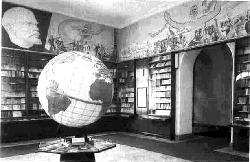Vladimir Lenin: The Great Ideological Legacy
V. I. Lenin's vast ideological legacy is exhibited in this hall. Various editions of his works both in the USSR and abroad are presented here. V. I. Lenin's first work to reach our time dates back to 1893 and the last to 1923. In 30 years V. I. Lenin wrote hundreds of books, thousands of articles, letters and a vast amount of reports. Over 21 thousand of his works and documents are published at present. Every edition of V.I.Lenin's Collected Works published in the Soviet Union is exhibited in the hall. The first edition was undertaken in accordance with a decision of the Party's Ninth Congress during Lenln's lifetime. It was published in 20 volumes and included over 1500 works. The decision of the Party's Central Committee of January 8, 1957 "On the Publication of the complete Collected Works of V. I. Lenin" (in 55 volumes) is presented in the display case. The first volumes of the 5th edition appeared in 1958 and the last was published in 1965. Almost nine thousand works and documents were included in this collection, almost 1,100 works being published for the first time. 38 collections of Lenin's writings published from 1924 to 1975, editions of selected works, collected works and separate works published in the USSR in Russian and national languages are on exhibit In the hall. The general circulation of the works of V.I.Lenin published in the USSR consisted of over 511 million copies as of January 1,1979. The genius of Lenin's ideas belong not only to the peoples of the USSR but to the working people of the entire world. In the middle of the hall stands a large globe. Here, the cities and countries where Lenin's works are published are marked with badges. There are hundreds of these badges on the globe. V.I. Lenin is translated into more foreign languages than any other author in the world. (See Revolution: the intellectual bases new site) The first collection of Lenin's works in Hungarian, published in Budapest in 1919 under the title of The Path of Struggle is on exposition. Included in this collection are the "Letters on Tactics", "The April Theses" and other materials. In 1919 Bulgarian Communists formed the co-operative society, "Liberation", having a large publishing department whose tasks were the issuing and distribution of Marxist revolutionary literature. V. I. Lenin's article "The Importance of Gold Now and After the Complete Victory of Socialism", published in a separate pamphlet, and other works that appeared from this publishing house are on display. German Communists illegally published Lenin's "Left-Wing" Communism, an Infantile Disorder during the years of fascist reaction and spread it under the disguise of a reference book In tourism and sports. Corn-munists in Argentina, despite cruel persecutlon by police, published the complete Collected Works of V. I. Lenin in 43 volumes in Spanish. The edition consisted of 276 thousand copies. V. I. Lenin's works are systematically published in over 50 countries, including England, France, the USA, Brazil, Finland, India and all the socialist countries. They are presented in the hall. Also on display here is the twelve-volume anniversary edition of V. I. Lenin's works that appeared in Japan for the 90th anniversary of his birth. A two-volume edition of V. I. Lenin's works was published in New York, Athens, Milan, Oslo, Brussels, Tokyo and other cities in the post-war years. As of January 1, 1977 the works of Lenin had been published throughout the world in 126 languages. The friezes on the walls of the hall graphically display the significance of Leninism to the working people of the Soviet Union, paving the way to communism, to the peoples building socialism, and to those struggling for the victory of democracy and socialist revolution or who take a stand for the formation and strengthening of national independent governments. The Victory of Socialism in the Soviet Union (1925-1941) |
